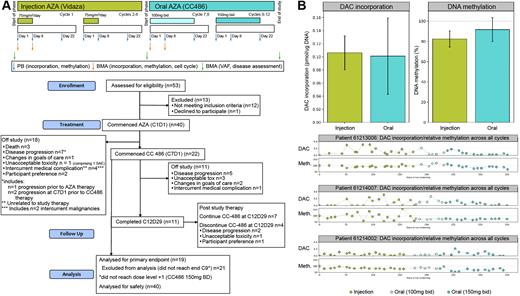Abstract
Introduction: Hypomethylating agents (HMAs) are the mainstay of treatment for high-risk myelodysplasia (HR-MDS), chronic myelomonocytic leukemia (CMML) and low-blast acute myeloid leukemia (LB-AML). Injection azacitidine (AZA;5-AZA-cR, Vidaza®) is a commonly used formulation that is administered at 75mg/m2/day over 7 days in repeated 28-day cycles. CC-486 is an oral AZA formulation, which we administered at 150 mg bid over 21/28 days for 4 cycles following 6 cycles of Vidaza and 2 cycles of CC-486 at 100 mg bid in an open label phase 2 multicentre investigator-initiated trial (NCT03493646). The primary objective was to compare in vivo 5- AZA-2'-deoxycytidine (DAC) incorporation and global deoxycytidine methylation in peripheral blood mononuclear cell (PB-MNC) DNA following either injection or oral AZA therapy. A secondary objective was to assess any relationship between these measures and clinical response. We also assessed changes in variant allele fractions (VAFs) of somatic mutations through different phases of treatment.
Study Design and Methods: MDS (IPSS; intermediate-2 or high-risk), CMML (bone marrow [BM] blasts 10-29%) and AML (20-30% blasts) patients were treated as shown (Fig A). Peripheral blood (PB) and BM samples were collected throughout, and clinical response assessed at the end of C6 and C12. DNA DAC incorporation and demethylation was measured by mass spectrometry (AZA-MS; Unnikrishnan et al Leukemia 2018). BM MNCs were utilized for AZA-MS and assessment of VAFs using a myeloid gene capture panel. Response assessment was performed according to IWG 2006 criteria.
Results: 40 patients commenced treatment, and of the 24 who completed 6 cycles of injection AZA, there were 15 responders (CR 4; mCR 3; PR 1; and HI 7) and 9 non-responders (SD;6; PD/failures 3) (Fig A). DAC incorporation was higher in responders than in non-responders 0.095 (95% CI 0.065-0.124) vs.0.048 (95% CI 0.010 - 0.085)] pmol DAC/µg DNA; p = 0.05). However, differences in DNA methylation relative to baseline (100%) were marginal between responders [83.2% (95% CI 74.76-91.69)] and non-responder [88.60% (95% CI 77.68 - 91.69] (p= 0.44).
22 patients entered the oral AZA phase and completed median 2 cycles (range 0-6); total 100 cycles of oral AZA were delivered. Reasons for discontinuation during the oral AZA phase (n=11) included disease progression (5 patients, 46%), unacceptable toxicity (3 patients, 27%), changes in goals of care (2 patients, 18%), intercurrent medical complication (1 patient, 9%). The most common adverse events during oral AZA therapy were hematological: 23 cycles in 13 patients were complicated by grade 4 neutropenia, 1 cycle in 1 patient by febrile neutropenia, 14 cycles in 10 patients by grade 4 thrombocytopenia. Other adverse events were uncommon, with 13 cycles in 9 patients complicated by grade 3 gastrointestinal toxicity (no grade 4 were observed).
11/22 patients who commenced oral AZA reached the second response assessment point comprising 7 responders (CR 2; mCR 4; HI 1) and 4 non-responders (SD 2; PD 1; relapse after CR/PR 1). The 7 responders at C12 included 5 responders and 2 non-responders at the end of injection AZA (C6). The 4 non-responders at C12 were responders at C6. Although sub-clonal structures showed temporal variation, most variant alleles persisted through both phases of treatment irrespective of clinical response.
19 patients were assessable for the primary outcome having completed at least one cycle of CC-486 at 150 mg bid (i.e., completed C9). Across these 19 patients, DAC incorporation was similar across both treatment modes (Fig B: inj. AZA; 0.106 (CI 0.080 - 0.132) vs. oral AZA 0.101 (CI 0.043 - 0.159) pmol DAC/µg DNA, p = 0.867), although there was more variation during the oral-AZA phase. DNA methylation changes compared to baseline was also similar [Fig B: 83.33% (95% CI 74.44 - 90.22) vs. 91.62% (95% CI 79.88 - 103.37); p = 0.066].
Conclusion: Crossover to CC-486 from Vidaza was generally well tolerated with comparable levels of in vivo DAC incorporation and DNA demethylation in MNCs in a population showing clinical outcomes comparable to historical data.
Disclosures
Pimanda:Abbvie: Honoraria, Membership on an entity's Board of Directors or advisory committees; BMS: Research Funding; Celgene: Research Funding. Fong:Pfizer: Consultancy, Honoraria, Speakers Bureau; Jazz: Consultancy, Honoraria; Otsuka: Consultancy, Honoraria; Amgen: Consultancy, Honoraria; BMS: Consultancy, Honoraria; BeiGene: Consultancy, Honoraria; Astellas: Consultancy, Honoraria, Research Funding; Abbvie: Consultancy, Honoraria, Speakers Bureau; Novartis: Consultancy, Honoraria. Hiwase:BMS: Consultancy, Membership on an entity's Board of Directors or advisory committees, Speakers Bureau; Novartis: Speakers Bureau; AbbVie: Speakers Bureau. Enjeti:AbbVie: Honoraria; Novartis: Membership on an entity's Board of Directors or advisory committees, Speakers Bureau; Roche: Speakers Bureau; Sanofi: Honoraria; Astra Zeneca: Honoraria. Hoenemann:Antengene Corporation: Ended employment in the past 24 months; Bristol Myer Squibb: Ended employment in the past 24 months; Otway Pharmaceutical Development and Consulting (OPDC Pty Ltd): Membership on an entity's Board of Directors or advisory committees. Hertzberg:Beigene: Consultancy, Honoraria; Gilead: Consultancy, Research Funding; Janssen: Consultancy, Research Funding; Novartis: Consultancy, Honoraria; Otsuka: Consultancy, Honoraria; Roche: Consultancy, Honoraria; Takeda: Consultancy, Honoraria. Unnikrishnan:Celgene: Membership on an entity's Board of Directors or advisory committees, Research Funding. Polizzotto:AstraZeneca: Research Funding; BRII Biosciences: Research Funding; Celgene/BMS: Consultancy, Research Funding; CSL Behring: Research Funding; Eli Lilly: Research Funding; Emergent Biosciences: Research Funding; Gilead Pharmaceuticals: Consultancy, Research Funding; GlaxoSmithKline: Research Funding; Grifols: Research Funding; Janssen/J+J: Research Funding; Takeda: Research Funding.
Author notes
Asterisk with author names denotes non-ASH members.


This feature is available to Subscribers Only
Sign In or Create an Account Close Modal